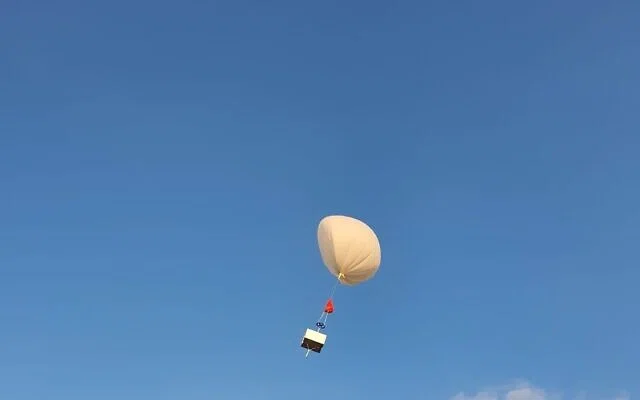Israeli balloon is believed to be the world’s first affordable, scalable technique for carbon capture.
The High Hopes Lab in central Israel, which gathers frozen carbon 9 miles above Earth, hopes to catch 1,000 metric tons per day for less than $50 per ton.
The sky isn’t the limit for an Israeli startup building carbon-capture balloons, which it claims will be the world’s first affordable, scalable technique of carbon capture.
Every year, the world’s population emits roughly 50 billion tons of greenhouse gases (GHG), primarily through the combustion of fossil fuels such as coal, oil, and natural gas. Global warming and climate change are mostly caused by this.
Not only is there a race to minimize the use of those polluting fuels, but also to collect surplus CO2 from the environment and store it for a long period.
Last month, the UN’s Intergovernmental Panel on Climate Change stated unequivocally that removal is required if the world is to reach the Paris Agreement’s climate targets and governments and businesses’ net-zero promises.
However, it claims that “technological, economic, institutional, ecological-environmental, and societal hurdles” are preventing progress.
According to Nadav Mansdorf, CEO of High Hopes Lab, based in Ramat Gan in central Israel, around half of the GHG are absorbed by nature each year, while the rest will have to be removed by humanity just to keep the pace of climate change where it is.
The company’s chief technological officer, Eran Oren, a physicist, alumnus of the army’s elite Talpiot program, and a self-described “problem solver,” invented the carbon-capturing balloon.
Oren’s invention will be patented, according to the US Patent and Trademark Office, which informed the lab last week.
“Carbon freezes at roughly minus 80 degrees Celsius (minus 112 degrees Fahrenheit),” noted Mansdorf, who has spent the previous 14 years establishing social and environmental impact organizations.
“Those temperatures can be found 15 kilometers (nine miles) above the Earth.”
Oren has developed a special material balloon that, when filled with hydrogen, can reach this altitude and carry a payload.
The carbon in the payload is separated and stored in a freezer section when the wind passes past it.
The weight of the carbon then drags the balloon back to Earth, where the solid carbon transforms into carbon dioxide gas.

It takes about two hours to complete the route.
The carbon dioxide can subsequently be sold to industry for use in operations ranging from plastic manufacturing to carbonated beverage production. It can also be buried (sequestered) underground, where it will gradually transform into limestone under tremendous pressure.
According to Mansdorf, the largest payload tested thus far weighed only a few kilograms. “What matters most is that we know it works.”
The first milestone will be to trap 50 to 300 kilograms (110 to 660 pounds) of carbon per day, per balloon, within the next year.
The “gamechanger” will be the second milestone, and the stats demonstrate that we can achieve it. “Per day, we’ll be able to catch one metric ton (2,205 pounds) of carbon.”
According to Mansdorf, the timeline of achieving that goal will be determined by available funding.
“Physics is working, and scientific parts have been confirmed.” There’s an engineering question that depends on the amount of resources we have.”
The company to beat is Climeworks, whose direct air capture facility in Iceland uses fans to capture ambient air, separates the carbon dioxide, mixes it with water, and injects it underground, where it will eventually turn into rock.
The factory can capture 1,000 metric tons (984 Imperial tons) each year, at a cost of around 1,000 euros per ton (just over $1,000).
“For our first milestone, we’re aiming for $100 to $250 per ton,” Mandsdorf said. “For the second milestone, we’re hoping to get to below $40 to $50.
“This is not about how to catch carbon. The unique thing about our solution is that we can do it at a huge scale, at a very low cost,” he said.

That cost is for capture, not for storage, though Mansdorf said there were already many places suited to carbon sequestration and that the balloons could be operated nearby.
But the main aim was eventually to recycle the carbon by selling it to industry.
“We were thinking about carbon capture for a long time,” Mansdorf recalled.
“Eran phoned me at 4:30 a.m. one morning, to say that he’d found the solution, and from there, the roller coaster began.
“We met everyone possible and asked them to tell us why we were wrong, why this was a dumb idea, but everyone — 100% of them — said, ‘You’re crazy. How can we join you?’”
Initially believing that their idea was so off-the-wall that nobody would invest, Mansdorf and Oren started out using their own funds.
But after they conducted experiments and realized that the idea would work, the investments started to flow in. The first round saw $1 million raised within three weeks, according to Mansdorf. The second brought in $5 million. The company is currently in the midst of a major, third funding round, and, according to Mansdorf, the interest is “huge.”
Source: Times of Israel

